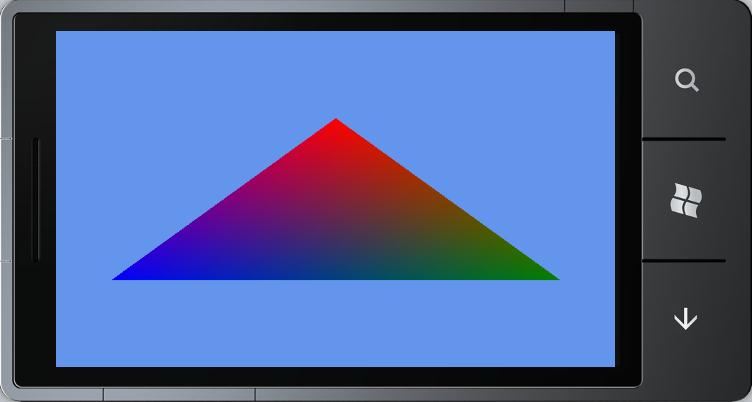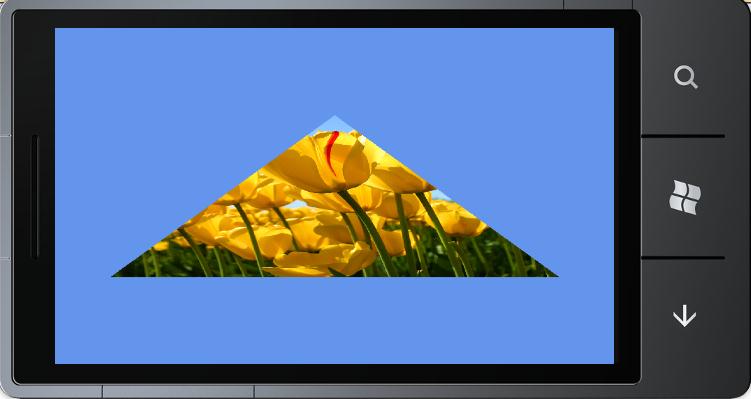Windows Phone 7 3D开发中使用纹理贴图
2011-03-14 23:47
459 查看
Windows Phone 7对3D的支持还是不错的,据说是用OpenGL/ES做的,使用起来倒是也有点那种感觉。另外,写本文的另一个原因是我的第一个3D试验竟然遇到了问题,花了1个小时才搞定,所以也一并记录下来,供遇到和我同样的问题的朋友参考。
本文就不讲XNA 4.0的游戏框架了,直接上一段代码,该代码使用VertexPositionColor渲染了一个三角形,程序运行一切正常。
运行结果如下:

在确认了3D开发的这种代码结构以后,用VertexPositionTexture渲染同样的三角形,只是这次采用纹理贴图,代码如下:
啰嗦一句,在此代码中VertexPositionTexture的第二个Vetex2代表的是UV坐标,对应的含义是(0,0)点对应了纹理图片的左上角,(1,1)点对应了纹理图片的右下角。
上述代码在运行的时候会在VS2010的输出窗口中显示:
A first chance exception of type 'System.NotSupportedException' occurred in Microsoft.Xna.Framework.Graphics.dll
A first chance exception of type 'System.Threading.ThreadAbortException' occurred in Microsoft.Xna.Framework.dll
同时模拟器里的程序直接退出,看不到结果。原因是什么呢?疑惑并仔细检视代码中……
与前一个彩色三角形对比,顶点顺序没变,摄像机位置没变,投影矩阵没变,按说是不可能出现这种问题的,而且程序直接崩了,没有信息抛出,真是很郁闷。
经过不断的试错,在宣布放弃之前,忽然想起来关于纹理方面的一个注意事项。有过3D开发经验的朋友都知道,纹理是要求符合2的整数次方对齐的,而我所加载的来自于外部任意图片的纹理不符合这一要求,所以程序挂了。
又查了一些资料,找到了准确的原因。原来是Windows Phone 7 的XNA中默认的纹理寻址模式使用了Wrap,造成了与GPU的不兼容,如果改成Clamp就好了。
看来在这个地方微软得要有文档说明才好,否则还真是难找问题所在。修改后的代码如下:
最终的模拟器结果是:

不管怎么说,Windows Phone 7的XNA游戏开发框架以及3D方面的开发接口还是很出色的,顶一下微软,并希望这个平台能尽快发展起来。
附Camera的代码:
——欢迎转载,请注明出处 http://blog.csdn.net/caowenbin ——
本文就不讲XNA 4.0的游戏框架了,直接上一段代码,该代码使用VertexPositionColor渲染了一个三角形,程序运行一切正常。
using System;
using System.Collections.Generic;
using System.Linq;
using Microsoft.Xna.Framework;
using Microsoft.Xna.Framework.Audio;
using Microsoft.Xna.Framework.Content;
using Microsoft.Xna.Framework.GamerServices;
using Microsoft.Xna.Framework.Graphics;
using Microsoft.Xna.Framework.Input;
using Microsoft.Xna.Framework.Input.Touch;
using Microsoft.Xna.Framework.Media;
namespace WindowsPhoneGame1
{
public class Game1 : Microsoft.Xna.Framework.Game
{
GraphicsDeviceManager graphics;
SpriteBatch spriteBatch;
Texture2D image;
VertexPositionColor[] trangle;
VertexBuffer vertexBuffer;
BasicEffect basicEffect;
Camera camera;
Matrix world = Matrix.Identity;
public Game1()
{
graphics = new GraphicsDeviceManager(this);
graphics.IsFullScreen = true;
Content.RootDirectory = "Content";
camera = new Camera(this, new Vector3(0, 0, 5), Vector3.Zero, new Vector3(0, 1, 0));
// Frame rate is 30 fps by default for Windows Phone.
TargetElapsedTime = TimeSpan.FromTicks(333333);
}
protected override void Initialize()
{
base.Initialize();
}
protected override void LoadContent()
{
spriteBatch = new SpriteBatch(GraphicsDevice);
image = Content.Load<Texture2D>(@"Images/Tulips");
trangle = new VertexPositionColor[]{
new VertexPositionColor(new Vector3(0, 1, 0), Color.Red),
new VertexPositionColor(new Vector3(1, -1, 0), Color.Green),
new VertexPositionColor(new Vector3(-1,-1, 0), Color.Blue)
};
vertexBuffer = new VertexBuffer(graphics.GraphicsDevice, typeof(VertexPositionColor), 3, BufferUsage.None);
vertexBuffer.SetData<VertexPositionColor>(trangle);
basicEffect = new BasicEffect(GraphicsDevice);
GraphicsDevice.SetVertexBuffer(vertexBuffer);
}
protected override void UnloadContent()
{
}
protected override void Update(GameTime gameTime)
{
if (GamePad.GetState(PlayerIndex.One).Buttons.Back == ButtonState.Pressed)
this.Exit();
base.Update(gameTime);
}
protected override void Draw(GameTime gameTime)
{
GraphicsDevice.Clear(Color.CornflowerBlue);
basicEffect.World = world;
basicEffect.View = camera.view;
basicEffect.Projection = camera.projection;
basicEffect.VertexColorEnabled = true;
foreach (EffectPass pass in basicEffect.CurrentTechnique.Passes)
{
pass.Apply();
GraphicsDevice.DrawUserPrimitives<VertexPositionColor>(PrimitiveType.TriangleStrip, trangle, 0, 1);
}
base.Draw(gameTime);
}
}
} 运行结果如下:

在确认了3D开发的这种代码结构以后,用VertexPositionTexture渲染同样的三角形,只是这次采用纹理贴图,代码如下:
VertexPositionTexture[] trangleTexture;
protected override void LoadContent()
{
spriteBatch = new SpriteBatch(GraphicsDevice);
image = Content.Load<Texture2D>(@"Images/Tulips");
trangleTexture = new VertexPositionTexture[]{
new VertexPositionTexture(new Vector3(0, 1, 0),new Vector2(0.5f,0) ),
new VertexPositionTexture(new Vector3(1, -1, 0),new Vector2(1,1f) ),
new VertexPositionTexture(new Vector3(-1,-1, 0),new Vector2(0,1f) )
};
vertexBuffer = new VertexBuffer(GraphicsDevice, typeof(VertexPositionTexture), trangleTexture.Length, BufferUsage.None);
vertexBuffer.SetData<VertexPositionTexture>(trangleTexture);
basicEffect = new BasicEffect(GraphicsDevice);
GraphicsDevice.SetVertexBuffer(vertexBuffer);
}
protected override void Draw(GameTime gameTime)
{
GraphicsDevice.Clear(Color.CornflowerBlue);
basicEffect.World = world;
basicEffect.View = camera.view;
basicEffect.Projection = camera.projection;
basicEffect.Texture = image;
basicEffect.TextureEnabled = true;
foreach (EffectPass pass in basicEffect.CurrentTechnique.Passes)
{
pass.Apply();
GraphicsDevice.DrawUserPrimitives<VertexPositionTexture>(PrimitiveType.TriangleStrip, trangleTexture, 0, 1);
}
base.Draw(gameTime);
} 啰嗦一句,在此代码中VertexPositionTexture的第二个Vetex2代表的是UV坐标,对应的含义是(0,0)点对应了纹理图片的左上角,(1,1)点对应了纹理图片的右下角。
上述代码在运行的时候会在VS2010的输出窗口中显示:
A first chance exception of type 'System.NotSupportedException' occurred in Microsoft.Xna.Framework.Graphics.dll
A first chance exception of type 'System.Threading.ThreadAbortException' occurred in Microsoft.Xna.Framework.dll
同时模拟器里的程序直接退出,看不到结果。原因是什么呢?疑惑并仔细检视代码中……
与前一个彩色三角形对比,顶点顺序没变,摄像机位置没变,投影矩阵没变,按说是不可能出现这种问题的,而且程序直接崩了,没有信息抛出,真是很郁闷。
经过不断的试错,在宣布放弃之前,忽然想起来关于纹理方面的一个注意事项。有过3D开发经验的朋友都知道,纹理是要求符合2的整数次方对齐的,而我所加载的来自于外部任意图片的纹理不符合这一要求,所以程序挂了。
又查了一些资料,找到了准确的原因。原来是Windows Phone 7 的XNA中默认的纹理寻址模式使用了Wrap,造成了与GPU的不兼容,如果改成Clamp就好了。
看来在这个地方微软得要有文档说明才好,否则还真是难找问题所在。修改后的代码如下:
protected override void LoadContent()
{
// Create a new SpriteBatch, which can be used to draw textures.
spriteBatch = new SpriteBatch(GraphicsDevice);
image = Content.Load<Texture2D>(@"Images/Tulips");
trangleTexture = new VertexPositionTexture[]{
new VertexPositionTexture(new Vector3(0, 1, 0),new Vector2(0.5f,0) ),
new VertexPositionTexture(new Vector3(1, -1, 0),new Vector2(1,1f) ),
new VertexPositionTexture(new Vector3(-1,-1, 0),new Vector2(0,1f) )
};
vertexBuffer = new VertexBuffer(GraphicsDevice, typeof(VertexPositionTexture), trangleTexture.Length, BufferUsage.None);
vertexBuffer.SetData<VertexPositionTexture>(trangleTexture);
basicEffect = new BasicEffect(GraphicsDevice);
GraphicsDevice.SetVertexBuffer(vertexBuffer);
GraphicsDevice.SamplerStates[0] = SamplerState.PointClamp;
} 最终的模拟器结果是:

不管怎么说,Windows Phone 7的XNA游戏开发框架以及3D方面的开发接口还是很出色的,顶一下微软,并希望这个平台能尽快发展起来。
附Camera的代码:
using System;
using System.Collections.Generic;
using System.Linq;
using Microsoft.Xna.Framework;
using Microsoft.Xna.Framework.Audio;
using Microsoft.Xna.Framework.Content;
using Microsoft.Xna.Framework.GamerServices;
using Microsoft.Xna.Framework.Graphics;
using Microsoft.Xna.Framework.Input;
using Microsoft.Xna.Framework.Media;
namespace WindowsPhoneGame1
{
public class Camera : Microsoft.Xna.Framework.GameComponent
{
public Matrix view{get;protected set;}
public Matrix projection { get; protected set; }
public Camera(Game game,Vector3 pos,Vector3 target,Vector3 up)
: base(game)
{
view = Matrix.CreateLookAt(pos, target, up);
projection = Matrix.CreatePerspectiveFieldOfView(MathHelper.PiOver4, (float)game.Window.ClientBounds.Width / (float)game.Window.ClientBounds.Height, 1, 100);
}
public override void Initialize()
{
base.Initialize();
}
public override void Update(GameTime gameTime)
{
base.Update(gameTime);
}
}
} ——欢迎转载,请注明出处 http://blog.csdn.net/caowenbin ——
相关文章推荐
- Windows Phone 7 3D开发中使用纹理贴图
- Windows Phone 7 3D开发中使用纹理贴图
- Windows Phone 7 3D开发中使用纹“.NET研究”理贴图
- 火云开发课堂 - 《Shader从入门到精通》系列 第十六节:在Shader中对3D模型使用纹理
- Windows Phone开发经验谈(16)-使用Async CTP简化异步编程
- Windows Phone开发使用横向滑动的ListBox
- 使用Unity 3D开发Hololens入门教程
- 国内使用Ogre 3D开发的游戏
- unity开发之四:摄像机渲染纹理RenderTexture的使用
- Windows Phone开发之xaml传值交互与控件hyperlinkButton和button的使用
- 初学WebGL,使用Three.js开发第一个3d场景示例
- 《Unity 3D脚本编程:使用C#语言开发跨平台游戏》序言
- OpenGL ES绘制3D纹理贴图
- 使用javascript开发windows phone应用的相关问题
- 火云开发课堂 - 《使用Cocos2d-x 开发3D游戏》系列 第二十五节: 3D项目优化方案
- Balder 3D开发系列之--给自定义基本体进行贴图操作
- 在Windows Phone中进行3D开发之十组件
- 使用纹理制作特效 - 压缩和混合纹理贴图
- 在Windows Phone中进行3D开发之十二飞行
- Windows Phone(三)WP7版 " 记账本" 开发(使用SQLite数据库)
